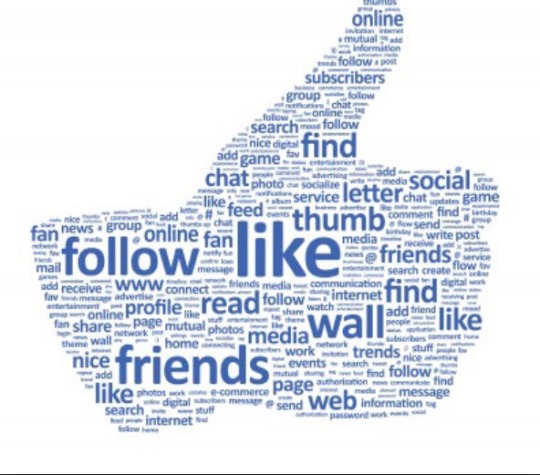Photo

Anonymous is a information activist group that shares information to the general public. This group has no set leaders and allows anyone to be apart of there movement. The anonymous class was formed when a group of people were protesting the church of Scientology. Soon afterwards, the group began to become popular and had many of thousands of protesters. My artifact relates to the Anonymous group because this is one of there online advertisements and it symbolizes that no one is the leader. This relates to day one because the sharing of information is a network.
1 note
·
View note
Photo

The article, "Queer youth, Facebook and faith: Facebook methodologies and online identities" written by Yvette Taylor, Emily Falconer and Ria Snowdon, describes how LGBT 'youth' use social media to help define them as they want to be seen. The article describes 38 LGBT's between the ages of 19-34, who are religious and experiencing expressing themselves on social media not by what sex they are, but by what gender they are. My artifact represents this article because on Facebook, the options are limited as to what people say about their gender. I also choose this image because when a LGBT youth is coming out on social media, like Facebook, it is important to feel accepted and be able to be honest with themselves. This relates to what we learned on day one, because this relates back to Network.
0 notes
Photo

United States of secrets In 2012, the untied states people found out that the NSA has been monitoring phone calls between domestic citizens. This all came out when an employee of the NSA saw this information, and decided that it was up to the American people had a right to decide it whether it was constitutional or not. This former employee of the NSA fled to Hong Kong to avoid the federal charges he committed. My artifact represents part two of the movie because big brother has escalated to a point were it is border line constitutional. And phone companies like Verizon, allow the NSA to tap into phone calls.
1 note
·
View note
Photo

United States of secrets, part 1 September 11, 2001 was the biggest event in my generations history. This marks the start of 'Big Brother' and the government secretly surveying hundreds of thousands of United States citizens. President George W. Bush, Vice President Dick Cheney along with other NSA and government officials secretly planned how to prevent terrorist attacks like 9/11 from ever happening again. This plan was called 'Thin Thread', and could tap into phone calls made from all domestic citizens. This was a legal document, signed and drafted by dozens of lawyers of the President and the Vice President that allows the NSA to legally wire tap into phone calls. My photo relates to the movie "United States of secrets" because the terrorist attacks of 9/11 unleashed a Pandora's box of unconstitutional wireless phone tapping that still continues today. This relates to what we learned on day one because it shows that in a world with increasing Internet, information is more easily obtained and security will always be a threat.
1 note
·
View note
Photo

Managing Public Outrage: Russia Over the years, the Russian government has had many scandals. In the past 10 years it is harder to keep a lid on scandals due to social networking sites and how fast information travels. In the article "Managing public outrage: power, scandal, and new media in contemporary Russia" written by Florian Toepfl, he talks about how in Russia a political scandal was commuted by Markovits was involved in 'a betrayal of the public trust in terms of the accountability and process of the liberal democratic state'. The public was very disappointed in this scandal and his poor moral choices. This story was spread through out social media. Scandals emanating from the new sphere of social media can both be beneficial and detrimental to the democratization of authoritative regimes. My artifact relates to this article because in the United States, we have Facebook and Instagram, but in Russia, they have their own social media sites in which information can spread.
1 note
·
View note
Photo

Maps 2.0: Cartography vs. Paper Maps For centuries, people used some form of a paper map to understand where they are going. This all changed when in 2007, a digital globe satellite was launched from an Air Force base in California. This satellite IKONOS, took almost 1 million high quality resolution photos of the globe, that was later made public (i.e. Google Earth). This changed how people all over the globe used maps. Now mostly everyone uses some form of the Internet to get directions of where they are going. This is both a good and bad scenario. It is good because it is more convenient and easier for the user. It is bad because this vast change in technology has created an information gap, where the newer generations do not know how to use a map, and only rely on digital maps. My image relates to this topic, because it compares a paper map and a virtual map on a tablet.
0 notes
Photo

Online emotional appeals have become more relevant in politics in the past decade. With the use of Web 2.0, politicians have capitalized on the capabilities of the Internet, and media. This has lead to the voters feeling more 'connected' to the candidate, and really humanizing them. Target affect in an emotional appeal, not just observer affect, influences citizens’ participation in an election. My artifact relates to the article "Online emotional appeals and political participation: The effect of candidate affect on mass behavior" written by Philip Edward Jones, Lindsay H Hoffman and Dannagal G Young because it talks about the 2008 election and President Obama's use of media and emotional appeals. This relates to what we learned on the first day because it talks about Web 2.0.
1 note
·
View note
Photo

The basic elements of creativity is the most primitive form oh how humans create something new. These elements are; copy, transform, and combine. Even today, copying is how humans learn. In school we all learn many things that have already been invented or learned, and nobody starts out original. By connecting ideas together, you can transform the information and create something innovating. My artifact shows the three basic elements of creativity, and the order that they come in. This topic is is significant to what we have learned in class because this shows that everyone copies from someone else's ideas. This is important because we live in a society that can claim ideas as their own and sue if you copy their idea.
1 note
·
View note
Photo

The MP3 crisis of the 1990's was the music industries lack of technological foresight and planning. Websites like Napster allowed listeners to illegally download music, plunging the music industry into an economic crisis. My artifact relates to this topic because it is a picture of someone illegally downloading music. This topic relates to new media because this was the beginning of the music era.
0 notes
Photo

Intimacy in the home has drastically changed in the past 10 years due to electronics such as tablets, smart phones and virtual video games. It used to be that 'family time' such as dinner or a family movie. Our society has become a dystopian society where family's do not connect in an intimate way. My artifact depicts a 'modern' family who are technically together, but aren't engaging with one and other. This cartoon family represent the average middle class family.
0 notes
Photo

Online dating has become one of the major ways to find 'love' as our culture becomes more influenced by the Internet. In the article, "Profile as promise: A framework for conceptualizing veracity in online dating self-presentations" written by Nicole B. Ellison, Jeffrey T. Hancock and Catalina L. Toma explains what is acceptable and what information is not acceptable on an online dating profile. The authors main argument in this article is a persons online profile vs. who that person is in real life. When young singles were interviewed, some came towards the consensus that not everyone's online dating profile is accurate. Many people on online dating sites over exaggerate or tell small white lies to make them sound better than they are. Some people feel that because they know it is probable that everyone else on the site is over exaggerating, they embellish as well. My artifact fits into what this article because this picture implies that finding love is as easy as clicking a button. This article relates to what we have learned in class because this online dating world has created a dystopian society. This causes the users to become further removed from the reality of dating. I liked the article and the information that it revealed. I think the authors were very convincing and provided a lot of well put together information. The only thing I would change would be that in their research, they could have a world wide perspective and not just in the U.S.
0 notes
Photo

The digital divide when new technology was being developed, created a racial and class division between those who could afford to use the Internet, and those who could not. Now the digital divide refer to those who have gaps in education. Meaning those who know how to use the Internet to its full potential, and those who cannot or chose not to. This artifact represents the digital divide well because it shows that the man on the left is the modern American and is using the Internet. And on the right, a man who is unwilling to adapt to the use of the Internet.
0 notes
Photo

The article, "Norm evolution and violation on Facebook" by Caitlin McLaughlin and Jessica Vitak, explains the social norms and expectations on Facebook. These norms are unwritten rules of how to behave and interact on Facebook. With so many Facebook users, there is a large variance on social norms in which norm violations occur. Norm violations can vary from positive to negative reactions, based on each user. A positive violation is maybe a Facebook friend sending you an online gift. A negative violation could be a friend posting something silly or something that makes fun of the user. This artifact fits into this topic because it is a picture of a users Facebook profile getting many notifications, fallowing the online social norm.
0 notes
Photo

The authors perspective on the article "Norm evolution and violation on Facebook," it that social media has a heavy influence on teenagers in society today. McLaughlin explains that there are both positive and negative violations on social media. My diagram represents this article because it shows how influential Facebook is on young teenagers. This fits into what we have talked about so far because social media has caused our society to publicly announce even the small insignificant parts of our daily lives. This has caused our culture to become a confessional society. We can know what someone is doing from online, making our private lives public.
0 notes
Photo

Networks can connect people and their devices to other people across the globe. I chose this artifact because this is a great example of how a social media site, like Facebook, can connect the user. This artifact is relevant to what we went over in class today because we talked about connectivity. We can communicate and interact with many social media sights. A network is very complicated, and requires many different machines to function.
0 notes